Welcome to our beginner's guide on how to play disc golf! Did you know that disc golf is one of the fastest-growing sports in the US? If you have seen people throwing frisbees at those weird-looking things with chains in your local park, that is disc golf!
Disc golf's popularity is growing immensely and for several reasons. Disc golf is inexpensive when compared to traditional golf. Many disc golf courses sit in beautiful areas, making the whole sporting experience amazing! People of all ages can play it.
During the COVID lockdown, disc golf grew exponentially! People discovered it as a great way to be outdoors without putting yourself at risk of the virus.
If you're ready to start the sport yourself we've written an easy-to-understand, yet in-depth guide on how to play disc golf!
The Basics
To play disc golf you need a disc golf disc. If you don't have one and you want to play ASAP, you can make do with a frisbee.
Shop for beginner-friendly discs here.
Now you need to find a disc golf course. You can use an app like UDisc to find courses. Otherwise a quick search on Google Maps for "disc golf courses near me" should do the trick!
Disc golf courses like golf courses are generally 9 or 18 holes. A disc golf "hole" is called a basket. The idea is to throw the disc into the chains. The chains will catch the disc and drop it into the basket below. This is called putting.
Disc golf courses will generally have cement tee pads for you to throw from. Some smaller courses may just have dirt tee pads. You can find maps on UDisc which will help you to navigate the course.
The Aim Of The Game
The goal you're trying to achieve when playing disc golf is to complete the course in as few throws as possible. You can break that down to each hole. Your object is to get your frisbee/disc from the tee pad and into the basket in as few shots as possible.
Once you have thrown your disc you move to where it landed and throw your next shot from there.
Each course has a total par which is the average number of strokes an adult player should take to complete the course. Finishing with fewer strokes is under par, and finishing with more is above.
Each hole on the course will have its own par. Most holes are par 3, but the number can vary from 2 to 6!
Let's break down how you would play a par 3 hole.
The Drive
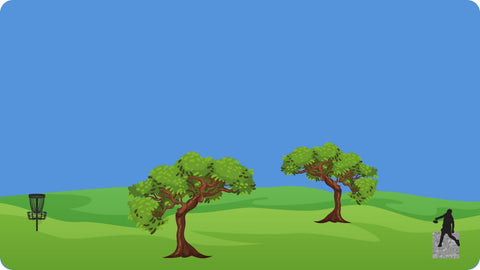
This is your first shot on the hole. It must be taken from the tee pad. Your goal here is really to cover as much distance as you can to get you to the basket. Do be warned you should not just throw as hard as you can! You'll score better if you rather throw 2 controlled shots to get to the basket!
The Approach
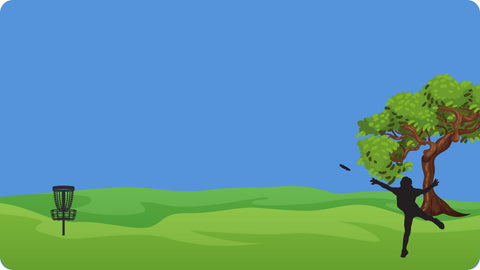
Approaching is when you are throwing the disc to get it as near to the basket as possible. The closer you can get to the basket the easier your putt will be! In this step, accuracy is crucial so take careful aim!
The Putt
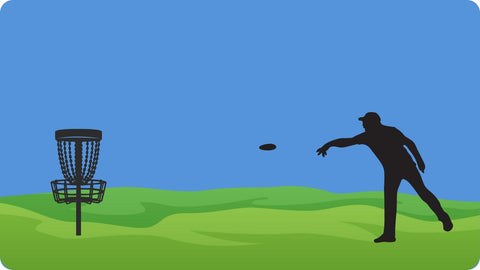
Putting is when you are attempting to get your disc golf disc into the basket. The action of a putt should be quite different to a full throw. We recommend you watch some disc golf putting tutorials to get the hang of it.
Once the disc is in you have completed the hole! If you miss the basket you move to your disc and try again from there.
Getting Par
Unfortunately scoring a par is not as easy as we just made it sound. As a beginner disc golfer, you should not expect to! We do recommend that you look for easier shorter courses in your area. These will be the most beginner friendly, and are a great way to start your disc golf career!
When you score 1 stroke below par on a hole it is called a birdie. For instance, getting 4 on a par 5 is a birdie. Getting a 3 on a par 5 would be an eagle, and if you got a 2 it would be an albatross!
What's more likely is that you'll take more strokes than par. If you scored 4 on a par 3 it would be a bogey. This goes on as a double bogey for 2 over par, and a triple bogey for 3 over par, etc.
We beg you not to be discouraged if you don't score well on your first round! Getting par in disc golf is more achievable than in traditional golf, and very soon you'll get your first birdie!
If you need a way to score you can print out some scorecards. UDisc can do some scoring for free and there are other apps out there.
Pro Tip: Don't bother to score on your first rounds. Just get onto the course and have fun!
Disc Golf Rules For Beginners
Now that you have the basics down we can get a little more nitty gritty. Don't get us wrong you already have enough knowledge to go out there and throw, and have a ton of fun! This is just for those of you who love to study the rulebook.
This is a simple guide to the disc golf rules most important for you to understand.
Where To Throw From
The first shot is easy, you just throw it from the tee pad. What about your next shot? You need to throw from where your disc landed, but where exactly is that?
The area you are going to throw from is called your lie. It's a 30cm by 20cm rectangle behind your disc facing toward the basket. The diagram below illustrates it better than what can be done with words.
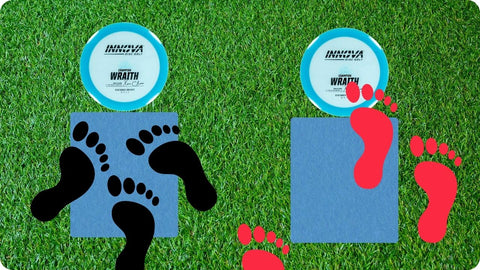
In tournament play throwing outside of your lie would be a foot fault. This would result in a stroke being added to your score, and you would have to retake the shot!
Out Of Bounds
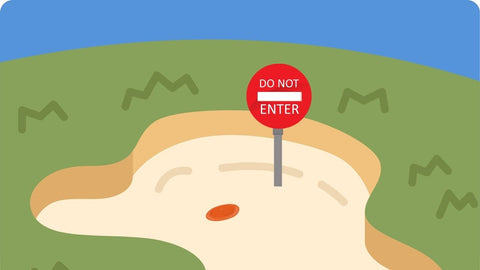
Out-of-bounds should generally be marked on a disc golf map, or the tee sign. If you cannot find any markings then you can play without worrying about OB.
Common OB areas are lakes, creeks, and cemented areas like sidewalks and parking lots. When your shot lands in one of these areas a penalty stroke is added to your score.
Where do you throw from after landing in OB?
When out of bounds is marked as a hazard it means that you must take your shot from where it landed.
With normal OB you would generally take your shot from where it first crossed the OB line. This can be hard to do because your disc crossed in mid-air. Just make a rough guess or ask your buddies to decide. Note that you can take your shot 1 meter away from the OB line where you crossed.
Some holes have a marked drop zone. When you throw OB on them you have to take your next shot from the dropzone. You also have a penalty stroke added to your score.
Mandos
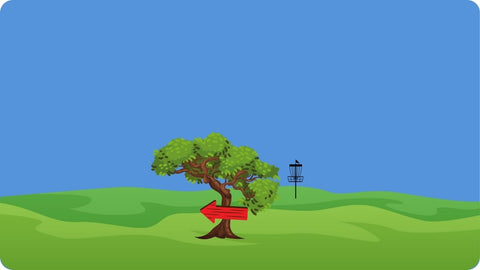
Mando is short for mandatory. A mando specifies the route that your disc must take past an object. For instance, a hole on your local course may have a tree that you must throw to the left of.
Mandos are often marked on the object, and they should also be on the tee sign. Mandos can force you to throw left of, right of, above, below, or through an object!
Idlewild Disc Golf Course in Burlington Kentucky features a famous Y-shaped tree that you have to throw through. The USDGC course has a man-made frame that you must throw through.
What happens when you miss a mando?
When you miss a mando a stroke will be added to your score. If you're just starting you may choose to ignore these rules. It's not a tournament, right?
Where do you throw from after missing a mando?
If there is a marked dropzone for missing the mando you must take your next shot from there. If there is no marked dropzone you have to retake the shot from the lie that you missed the mando from.
Circle 1 And Circle 2
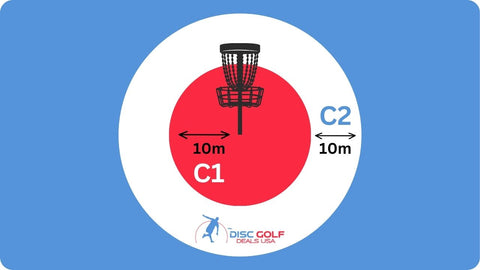
Circle 1 is anything within 10 meters of the basket. Circle 2 is anything between 10 and 20 meters from the basket. Some technical rules apply to each. These circles are rarely marked on the course so recreational players will generally estimate them.
Circle 1
When you're putting from circle 1 you must maintain balance behind your lie. If you step past your lie when you putt it is considered a foot fault and a penalty stroke will be added to your score! You will also have to retake the putt.
Circle 2
When you're in circle 2 you are allowed to jump putt to get more distance. This means that you support yourself past your lie once you have released the disc. Just be sure you release the disc before your feet leave the ground!
Note that you can jump putt from anywhere outside of circle 1, not just inside C2.
Losing A Disc
Possibly the worst aspect of this sport is losing your disc! Thankfully it doesn't happen that often, but when it does you should know how to proceed.
The rules state that when a disc is lost you have to retake your shot. You will also have a penalty stroke added to your score.
This is pretty sad seeing as you just lost your disc. If you're just out there to have fun take your shot from where you think your disc landed. You can skip the penalty stroke too :)
Pro Tip: Throw brightly colored discs, these are easier to find. Avoid natural colors like green and brown. Orange discs can be hard to see in autumn leaves
How To Throw Disc Golf Discs
There are a multitude of crazy ways to throw disc golf discs. The two main ones are backhand and forehand. Backhands resemble a traditional frisbee throw, whereas forehands are more like throwing a baseball. We suggest you watch some tutorials on how to throw both of these shots.
Backhand
Backhands are the most common shot type in disc golf. When you throw a backhand the disc will move to the left at the end of its flight. (if you are right-handed) Throwing backhand results in the most distance, although beginners often struggle with the timing of this more complex shot.
Forehand
Throwing side arms is all about getting a good flick of the wrist. It's a similar motion to throwing a baseball or whipping a towel. Beginners often find forehand the easiest shot type when they start. It also allows you to look where you're aiming, increasing your accuracy!
Which Are The Best Discs For Beginners?
As a beginner, you should start by throwing slow-speed discs. This means putters and midranges. Yes unlike traditional golf you can use putters off the tee! Almost every pro disc golfer does this. These slower-speed discs are easier to control and will fly further for those new to the sport!
If you want to learn all about how discs fly, and which ones are the best for beginners read this post: Overstable vs Understable
If you're looking for the perfect beginner disc buy one of these MVP Glitches. They're the most frisbee-like disc golf disc you can buy. If you're transitioning from ultimate the Glitch is perfect!
[product=mvp-neutron-soft-glitch]
[/product]
If you have any disc golf related questions just leave us a message on our live chat, we'd love to help get you into the sport!





































































































































































































































































Should you buy a putter disc & a regular disc
Disc golf will make you very happy. But also extremely grumpy.